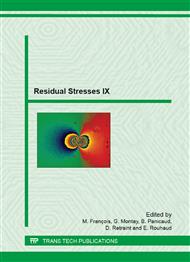p.355
p.361
p.367
p.373
p.380
p.386
p.392
p.398
p.404
Residual Stress Measurement of Shot-Peened Steel Rings by Barkhausen Noise, ESPI Hole-Drilling and X-Ray Diffraction
Abstract:
Shot-Peening is used to generate surface-near compressive residual stresses in final shape parts, usually to improve their fatigue properties. The success of the process can be checked in different ways. XRD and Hole-Drilling determine quantitative stress depth profiles in specific locations. Barkhausen noise measurements evaluate a near-surface zone in real-time and can cover large areas quickly. It is a fully nondestructive method. This study compares ESPI Hole-Drilling, which is a very fast technique, and XRD, which is very precise but slower, to Barkhausen Noise results for the case of three steel rings shot-peened with different intensities.
Info:
Periodical:
Pages:
380-385
Citation:
Online since:
August 2014
Authors:
Permissions:
Share:
Citation:


